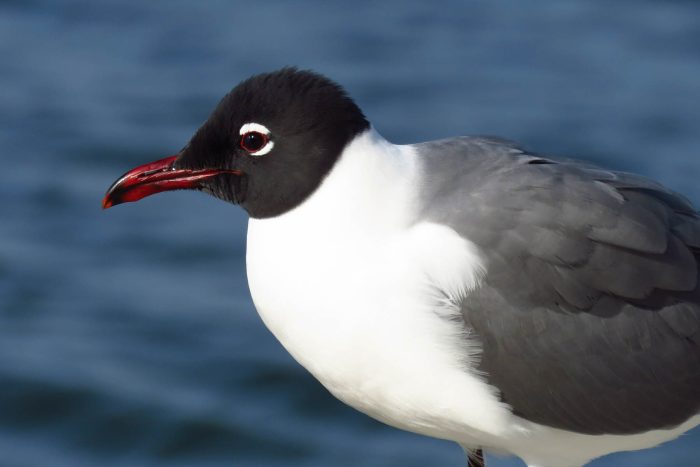Laughing Gull
Leucophaeus atricilla
Laughing gulls are medium-sized gulls with white underparts and a gray back. They visit the Chesapeake Bay in the summer to breed.
This section shows one large critter image at a time. Use the thumbnails that follow to select a specific image to display here.

This gallery contains a grid of small thumbnails. Selecting a thumbnail will change the main image in the preceding section.
Appearance
Laughing gulls have white underparts and a dark gray back. The wings are dark gray with black tips. The legs vary in color from dark orange to black. During the breeding season, laughing gulls have a black head and a deep red bill. In winter, the bill is black and the head is white with a smudge of gray. Immature gulls are variably colored, but are generally mottled brown and tan.
Feeding
Laughing gulls eat a wide variety of foods, including fish, insects, mollusks and garbage. They will also hover over freshly plowed farm fields in spring to search for grubs. Laughing gulls sometimes eat the eggs of other bird species, but not as frequently as other gull species.
Predators
Eagles, herons, foxes, raccoons and domestic cats and dogs all prey upon gulls.
Flight
Laughing gulls hold their bill straight ahead while in flight.
Voice
Laughing gulls have a shrill, laugh-like call.
Reproduction and life cycle
Laughing gulls nest from late May to early August in sand dunes and salt marshes. They nest in breeding colonies with other gulls in groups of up to 25,000 pairs. Both male and female birds will help build the nest, although sometimes the male begins the process as a way to attract a mate.
Laughing gulls are monogamous and a pair can stay together for several breeding seasons. Females lay three olive to buff-colored eggs, which hatch in about 20 days. They reach maturity in three years.
Did you know?
- Laughing gulls are named for their distinctive, laugh-like call.
- Have you ever wondered why gulls hover over bridges? They do this to absorb the rising heat from the paved roadway, which helps them conserve energy while looking for food.
- The oldest known laughing gull was 22 years old when it was killed in Maine.
Sources and additional information
- Life in the Chesapeake Bay by Alice Jane Lippson and Robert L. Lippson
- Chesapeake Bay: Nature of the Estuary, A Field Guide by Christopher P. White
- Animal Diversity Web: Larus atricilla – University of Michigan Museum of Zoology
- All About Birds: Laughing Gull – The Cornell Lab of Ornithology
